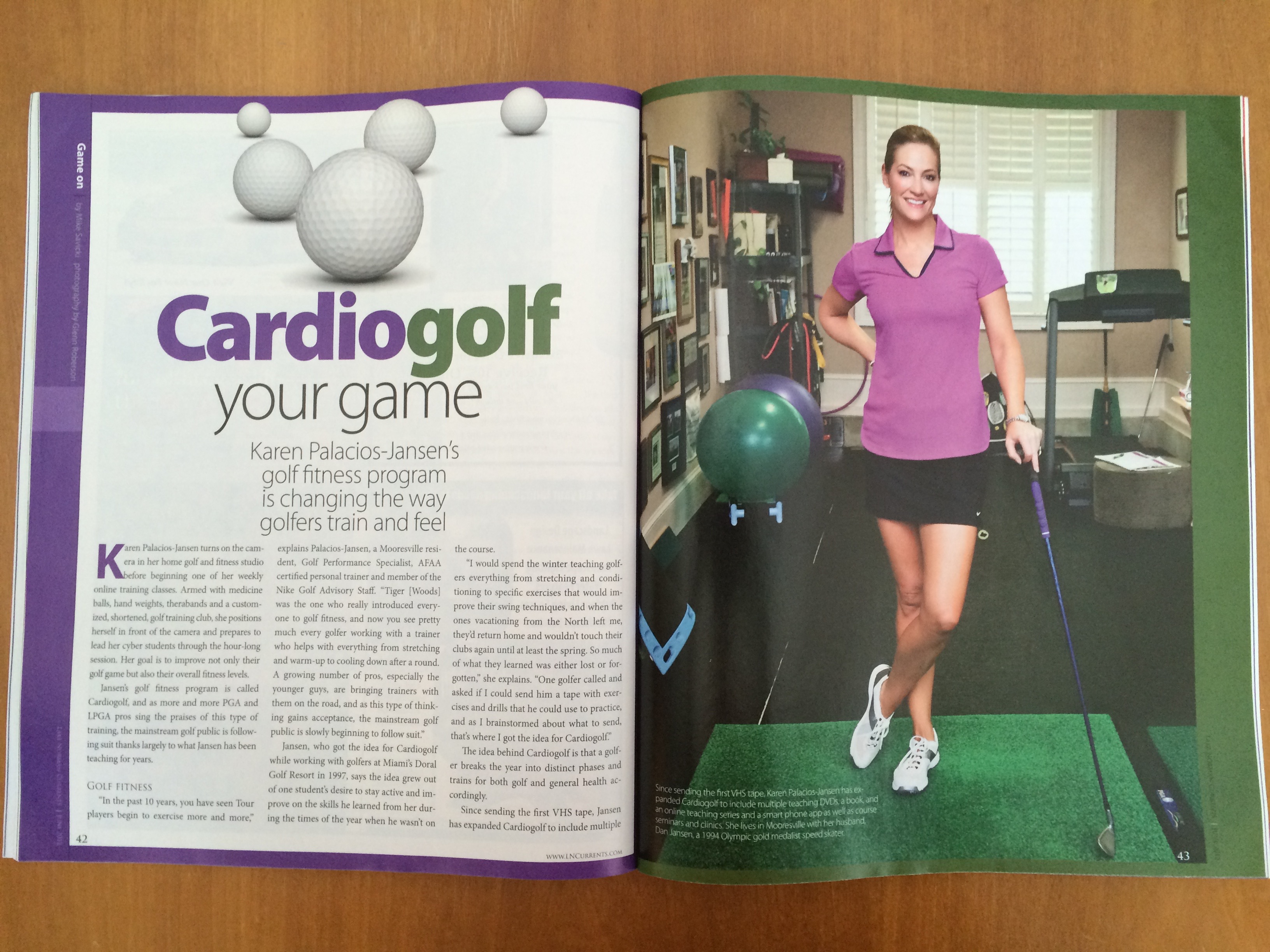Cardiogolf Your Game
Karen Palacios-Jansen’s golf fitness program is changing the way golfers train and feel
By Mike Savicki
Karen Palacios-Jansen turns on the camera in her home golf and fitness studio before beginning one of her weekly online training classes. Armed with medicine balls, hand weights, therabands and a customized, shortened, golf training club, she positions herself in front of the camera and prepares to lead her cyber students through the hour long session. Her goal is to improve not only their golf game but also their overall fitness levels. Jansen’s golf fitness program is called Cardiogolf, and as more and more PGA and LPGA pros sing the praises of this type of training, the mainstream golf public is following suit thanks largely to what Jansen has been teaching for years.
“In the past 10 years, you have seen Tour players begin to exercise more and more,” begins Karen Palacios-Jansen, a Mooresville resident, CHEK Golf Performance Specialist, AFAA certified personal trainer and member of the Nike Golf Advisory Staff. “Tiger [Woods] was the one who really introduced everyone to golf fitness, and now you see pretty much every golfer working with a trainer, who helps with everything from stretching and warm-up to cooling down after a round. A growing number of pros, especially the younger guys, are bringing trainers with them on the road, and as this type of thinking gains acceptance, the mainstream golf public is slowly beginning to follow suit.”
Jansen, who got the idea for Cardiogolf while working with golfers at Miami’s Doral Golf Resort in 1997, says the idea grew out of one student’s desire to stay active and improve on the skills he learned from her during the times of the year when he wasn’t on the course.
“I would spend the winter teaching golfers everything from stretching and conditioning to specific exercises that would improve their swing techniques, and when the ones vacationing from the north left me, they’d return home and wouldn’t touch their clubs again until at least the spring. So much of what they learned was either lost or forgotten,” she explains. “One golfer called and asked if I could send him a tape with exercises and drills that he could use to practice, and as I brainstormed about what to send, that’s where I got the idea for Cardiogolf.”
The idea behind Cardiogolf is that a golfer breaks the year into distinct phases and trains for both golf and general health accordingly.
Since sending the first VHS tape, Jansen has expanded Cardiogolf to include multiple teaching DVDs, a book, an online teaching series and a smart phone app, as well as course seminars and clinics. A shortened, balanced training club is a central component of her program, and incorporating it into training sessions lets golfers practice their full swings even indoors in front of a web cam.
“When a student called and told me his wife wouldn’t let him practice indoors anymore because he broke the chandelier swinging a club, I got the idea for the shortened training club,” she jokes, adding, “With traditional lessons or online instruction, you typically watch an exercise inside then have to go outside to practice it. The shorter practice club allows you to work with me right inside and go through warm-up, stretch routines and all the swing drills.”
Form and function
Jansen’s Cardiogolf incorporates proven techniques with modern sport science.
The 2008 LPGA Teacher of the Year explains, “Traditional thinking preached that you needed to be stronger to generate more club head speed, but it really begins with flexibility. And to train for golf, you want to do exercises that create long, lean muscles. This creates a bigger range of motion that allows you to make a bigger swing arc, and with a bigger swing arc you can generate more club head speed.”
Jansen says the average male golfer generates approximately 90 mph club head speed,
and the average female tops out at between 80 – 85 mph. Of Cardiogolf’s many benefits, Jansen believes a golfer might add between five to ten mph to their swing, while also fine tuning and ingraining the correct mechanics of the swing.
“Cardiogolf is about creating balance, stability, core strength and good habits,” she adds. “If you compare a one-hour class to one hour of hitting balls on the range, for example, in the class you are swinging the club on and off more in the hour than you would be just hitting balls. Plus, you are getting the benefit of building a sound swing versus repeating the same habit over and over alone on the range.”
Cardiogolf can be tailored to golfers of all ages and abilities, but Jansen says two main types of golfers praise it the loudest.
“The total beginners learn the proper mechanics of the swing stroke not by trying to hit a ball but by learning all the stroke phases without the pressure of hitting the ball before being ready,” Jansen states. “And the forty-five to sixty-five year old male who has been playing for some time but doesn’t do much strength or conditioning on his own takes away tremendous health benefits from the program.”
She adds, “But I have had some people do it for weight loss, some to increase flexibility, some to increase strength and some to improve swing mechanics. The program can be tailored to fit so many different goals and it really comes down to what a person is looking for.”
Jansen knows from experience that golf is a game of practice and repetition and concludes, “I would love to say that my program will lead to one type of result or another, but the thing about fitness is that it is power over time, and golf doesn’t work that way either. You can’t just do something once and expect quantifiable results. My program kills two birds with one stone, but no matter what you choose to do, success comes with hard work, commitment and practice.”
This article was originally published in Currents Magazine in 2012.

